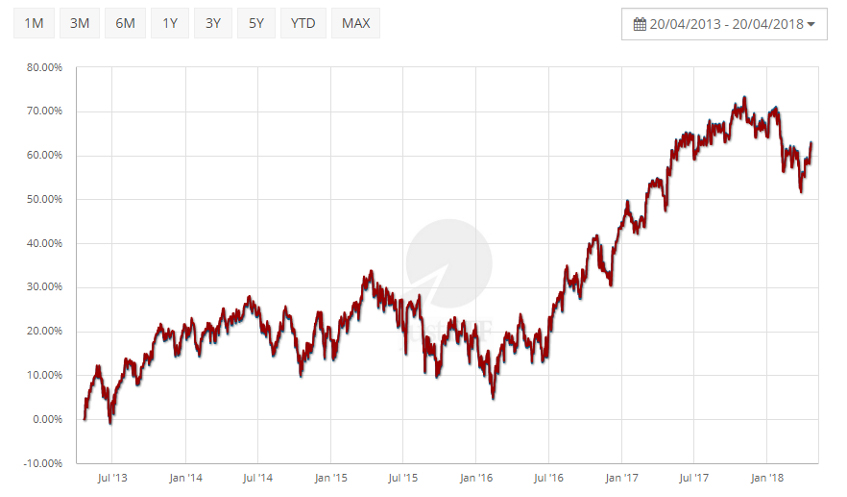
But why do ETFs that track the same index trade at very different prices? Is the iShares Core FTSE 100 UCITS ETF a screaming bargain at £7.31* per share versus the Vanguard FTSE 100 UCITS ETF at £32.80* per share? Shouldn’t both ETFs trade at £7.36 per share if the index is at 7368.17*?
*Values at April 20th 2018
It’s ETF performance that counts
Strange though it seems, the market price of an ETF is way down the list of priorities when you compare rival products. That’s because an ETF’s value is not defined by its market price, unlike with individual company shares.What matters, is the percentage change in the ETF price. It’s neither here nor there if you buy 60 shares of an ETF for £2,000 or 30 shares for £2,000. If the ETF goes up 10%, then the value of your holding will be worth £2,200 in both cases.
The price of an ETF will usually correspond to its Net Asset Value (NAV). The NAV equals the value of the ETF’s securities and other assets, minus its liabilities, divided by its number of shares:

The NAV is computed by the ETF’s independent custodian once a day.
- If the value of an ETF’s underlying assets rise, and the number of shares remains unchanged, then the price per share will also increase.
- If trading demand for an ETF’s shares increases, then more units are created. The increased supply of shares keeps the share price in line with the ETF’s NAV.
Accurate ETF comparison
Sometimes an ETF’s price looks high because it includes the value of dividends that have been automatically reinvested rather than distributed to investors. These types of fund are termed accumulating or capitalising.The price of a distributing ETF decreases in line with the amount paid out to investors, whereas an accumulating ETF will increase its price in line with the value of the dividends retained. Over the years that will lead to a wide price gap between two otherwise identical ETFs - but it’s a price difference not a performance difference.
In the chart below, you can see that overall performance is very similar over 5 years between the iShares EURO STOXX 50 UCITS ETF (Distributing) and the Source EURO STOXX 50 UCITS ETF (Accumulating).
Comparison of iShares EURO STOXX 50 UCITS ETF (Dist) and
Source EURO STOXX 50 UCITS ETF A

Source EURO STOXX 50 UCITS ETF A
iShares EURO STOXX 50 UCITS ETF (Dist)
iShares EURO STOXX 50 UCITS ETF (Dist)
Source: justETF.com; as of 20/04/2018
The iShares ETF’s share price is £31.04* while the Source ETF’s share price is £62.88.*
*Values at April 20th 2018.
It’s their performance versus the index that counts though, and so our charts calculate returns on a ‘dividends reinvested’ basis to enable an apples-to-apples comparison.
This helps explain why price isn’t an important factor versus variables such as cost and tracking difference. You can find out more about how to choose the best ETF’s in our Academy post.
Lower ETF prices can be more convenient
The advantage of lower share prices is that they can make portfolio management a little easier. A high share price may mean you can’t buy exactly the number of shares you would like, especially when you’re contributing monthly sums under £1,000.The table below shows why a lower price can help. You can’t buy fractional ETF shares, so a higher price can leave you with more cash sitting on the sidelines:
FTSE 100 ETF ‘A’ @ £37 per share
| Investment contribut. | ETF share price | Total no of shares | Uninvested cash | % of cash uninvested |
|---|---|---|---|---|
| £200 | £37 | 5 | £15 | 7.5% |
| £500 | £37 | 13 | £19 | 3.8% |
| £1,000 | £37 | 27 | £1 | 0.1% |
| £2,500 | £37 | 67 | £21 | 0.8% |
FTSE 100 ETF ‘B’ @ £3.70 per share
| Investment contribut. | ETF share price | Total no of shares | Uninvested cash | % of cash uninvested |
|---|---|---|---|---|
| £200 | £3.70 | 54 | £2 | 1.0% |
| £500 | £3.70 | 135 | £0.50 | 0.1% |
| £1,000 | £3.70 | 270 | £1 | 0.1% |
| £2,500 | £3.70 | 675 | £2.50 | 0.1% |
The ability to buy more shares at a lower price means you can funnel your cash into the market more efficiently, especially if you like to automate your contributions. Research proves that it’s generally better to put your cash to work in the market for as long as possible and lower prices make that, and rebalancing to your precise asset allocations, easier.
Key takeaways
- Different prices are nothing to worry about among ETFs tracking the same index and do not contain important performance-related information.
- Lower prices do enable you to invest more efficiently and to fine-tune your portfolio management.

















